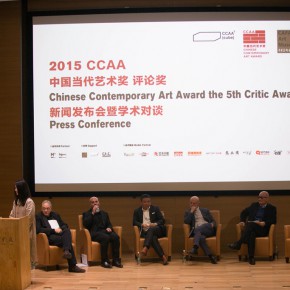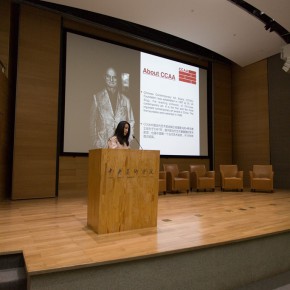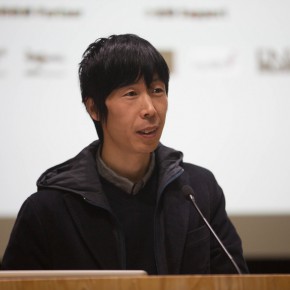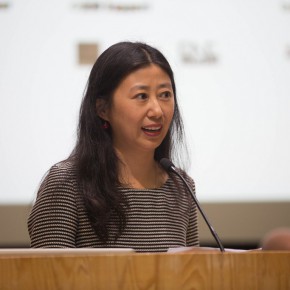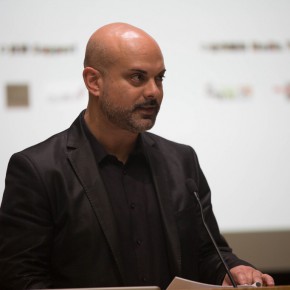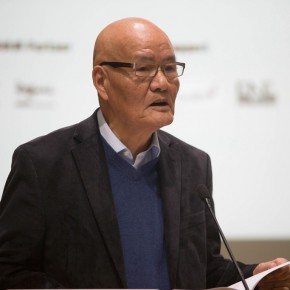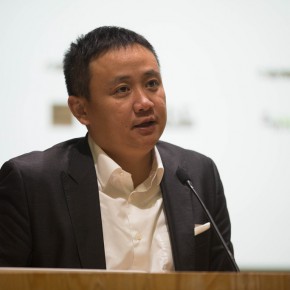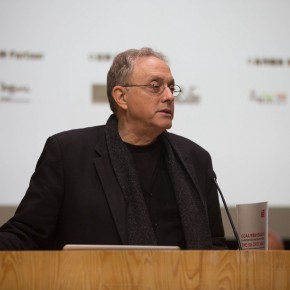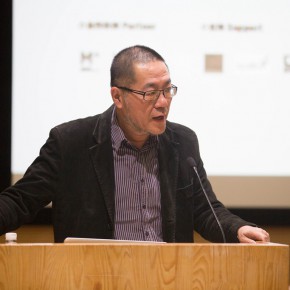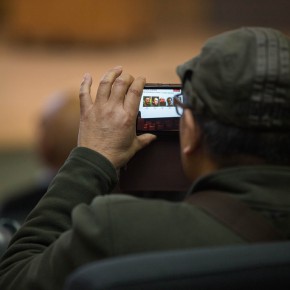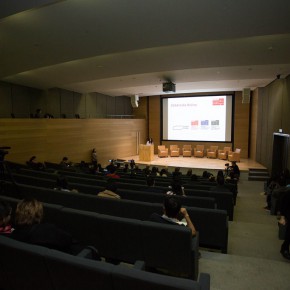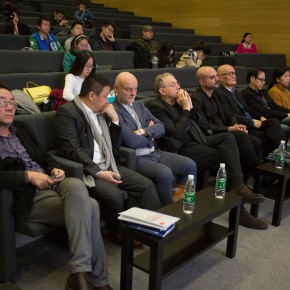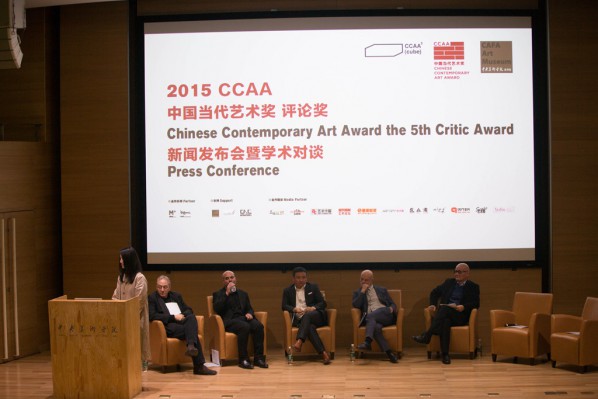
On the afternoon of October 27, 2015, the press conference of 2015 CCAA Chinese Contemporary Art Critic Award as well as the academic seminar were held at the auditorium of CAFA Art Museum. It is the second time for the award to be announced at the Central Academy of Fine Arts after an interval of two years. This year's CCAA Critic Award is granted to Yu Miao for her book proposal "From the Street to the White Cube, and Away again...: Artists' Intervention Practice in the System of Circulation in Chinese Contemporary Art."
This press conference was chaired by Liu Li Anna, Director of CCAA and honored guests present at the event including Charles Guarino, Publisher of Artforum International Magazine, Mark Rappolt, Editor-in-Chief of ArtReview and Art Review Asia, Pi Li, Senior Curator of Hong Kong M+ Visual Culture Museum and Art Critic, Uli Sigg, Founder of CCAA and collector, Zheng Shengtian, Managing Editor of Yishu: Journal of Contemporary Chinese Art, Wang Huangsheng, Director of CAFA Art Museum, Prof. Wang Chunchen, and Dong Bingfeng, previous winner of the CCAA Critic Award.
First of all, Wang Huangsheng expressed that, “It is the 18th year since CCAA established its first Chinese contemporary art critic awards in 1998, its continuous discussions on the issues and criterion of Chinese contemporary art has promoted the developments of Chinese contemporary art. In recent years, the press conferences of CCAA as well as related seminars and dialogues have been held in the lecture hall of CAFA Art Museum, we hope these events would profoundly inspire the students and teachers of the Central Academy of Fine Arts as well as the world of Chinese contemporary art to jointly discuss and participate into it, to make the developments of CCAA in China more conspicuous with their practices."
Liu Li Anna, Director of CCAA, introduced the development of CCAA in the past 18 years. From a semi-underground state to the world stage, from small-scale discussions to a truly high-end academic exchange on a global level, CCAA followed with great interest how Chinese Culture encountered and interacted with Western culture as well as explored how our contemporary era was confronted with and inherited our tradition. The selection of the awards in the past 18 years can be viewed as a consistent effort to explore the possibilities for individuality to coexist with collectivity, and the mainstream with the marginal and also its persistence in supporting and encouraging creative art practice. It has actually built a platform for all those who are interested in contemporary art, Chinese contemporary art in particular, to reflect on and relive these impressive 18 years. The jury was presented with 26 proposals for books to be published. The applicants presented a truly diverse range of approaches. As a whole these entries suggested shared views about the key challenges facing Chinese contemporary art today. But, importantly, they presented a wide range of opinions about how to address or overcome these challenges. The jury was impressed by both the quality and the sophistication of the proposals submitted, which suggests a certain vitality in the critical discourse surrounding contemporary art in China – a vitality that the CCAA Art Critic Award hopes to strengthen further.
The Awarding Proposal and Statements of the Jury
Ms. Yu’s proposal, “From the Street to the White Cube and Away Again; Artists' Intervention Practice to the System of Circulation in Chinese Contemporary Art”, will research - using circulation as a framework - the ways in which Chinese artists have appropriated and intervened in media and business, with and through their artistic practices. By examining artists’ strategic and tactical interventions using case studies, the author will attempt to illustrate the major shifts that occurred during the 1990s through to the present day.
During the 1990s, many artists appropriated advertising, newspaper, supermarket and trade show spaces as “ready made” exhibition spaces. They saw the avant-garde potential in displaying their work in public circulation, confronting their audience with artwork that re-configured the otherwise familiar spaces. In doing so, the artists assumed the divergent roles of designer, editor and manual laborer.
As the gallery-based system for exhibiting art rapidly developed around them, the dynamics of their work assumed a new urgency, engendering a dialogue about the value of art and the values created in and around the means of its exhibition.
Artists engaged in this practice made consistent attempts to negotiate the shifting relationship between art and commerce and the relationship of both in a global context. The evolution of this phenomenon over the last few years, and the relationship of some of China’s most seminal artists as they circulate within an international audience, continues to inspire an essential inquiry into the phenomenon of “circulation”. It can provide a fresh perspective in the research of Chinese contemporary Art.
Yu Miao was awarded a Ph.D from the Department of Communication Studies and Art History at McGill University. She is a founding member of the “Temporary Pavilion” in Shengyang. She is currently the Curator of Public Programs at OCT Contemporary Art Terminal in Xi’an. She expressed her gratitude to Uli Sigg, as well as all the CCAA members led by Liu Li Anna, her family and friends in her speech. She described her feeling that “sitting on a cold bench” was the term usually used to describe a long-term austere work, but she thought “warming the bench” could not be taken as a grinding process, it needed persistent enthusiasm, from the moment she got the award she started the process of warming it with all her enthusiasm.
Dong Bingfeng, the winner of 2013 CCAA Chinese Contemporary Art Critic Award reported on the accomplished procedure of his proposal at the press conference. He was consulting with the publishing house in Taiwan about his upcoming book “Exhibiting Films: Films in the Chinese Contemporary Art” and he hoped that they would provide a complete Chinese version for him. Also he thought that we should pay more attention to the art creations besides art museums, including art and non-art discussions, such as the directors and artists of independent films who were based in China in the past twenty years, therefore he has researched many cases.
Text by Ye Yuanfeng, Photo by Yang Yanyuan/CAFA ART INFO
Translated and edited by Sue/CAFA ART INFO
From the Street to the White Cube, and Away again…: Artists’ Intervention Practice in the System of Circulation in Chinese Contemporary ArtYu Miao
Circulation initially refers to the process of a commodity moving from the field of production to the field of consumption in a business context. However, in the era of globalization, this concept has expanded to include the regional and global influx of commodity, capital, labor, ideas, information, imagse and human migration. The infrastructure and the mechanism of circulation not only consists of a transportation network, telecommunication technology, media, spaces of production and consumption, but also the power formation behind the infrastructures.
This research examines the ways in which Chinese artists have appropriated and intervened in the systems of circulation in business, media and contemporary art. By looking at artists’ strategic and tactical practices in concrete case studies, this project attempts to present two major shifts that occur from the early 1990s to the post-Olympics and to the present day. First, in the 1990s, a number of emerging artists, including Wang Youshen, Ren Jian, Zhu Fadong, Zhao Bandi, Zhou Tiehai, Song Dong, Wang Jin, Xu Zhen, Zhang Dali and Shi Yong actively appropriated advertiisng, popular newspapers, the supermarket space, tradeshow and even courier service as “readymade”. Initially as a solution to the lack of exhibition space, the artists gradually saw the avant-garde potential in displaying their works in the public circulation systems. By circulating their own images and staging real situations in the public, the artists confronted the public with artworks and re-configured the public space. In this process, the artists operated in a wide public arena and assumed divergent social roles such as designer, editor, entrepreneur and even temporal manual labourer. Second, since 2000, as China’s art exhibition system and art market rapidly developed, many artists paid increasing attention to the circulation of artworks in the art system and the ways in which values are being created in the process. Artists including Yan Lei, Xu Zhen, Ai Weiwei, Cai Guoqiang, Wang Sishun, Zhao Zhao and Shi Qing made constant attempts to negotiate the shifting relationships between art and commerce, between the artist self and the global art system. Some of their practices search for a new and productive relationship beyond the buying and the selling of the artworks. Nevertheless, their institutional critiques also run the risk of being institutionalized.
The key questions for this project are: can we use “circulation” as a new conceptual framework to examine Chinese artists’ interventions to the social, the institutional and the media public spheres? During this process, how did the artists construct their images, re-adjust their social roles, create new values and reconfigure new subjectivities?What are the relationship between the intervention practice to circulation and the configuration of artists’ public roles? As contemporary art in China is increasingly disconnected from its own history, can looking back at the artist practices in the 1990s provide us with inspirations and solutions to today’s problems?
Post-89: The Proliferation of “Self”
The 1990s lifted its curtain under the paralleling forces of political oppression and the state-sanctioned market reform. In the art field, the ’85 New Wave, a collective modern art movement, hastily came to its end in 1989. After a period of relative silence, a young generation of artists entered the public arena through the exhibition “New Generation” in 1991. Mostly born in the 1960s, these artists had no deep experience of the Cultural Revolution and didn’t possess the kind of social responsibility to enlighten the masses as seen in the artists of the ’85 New Wave. Situated in a society devoid of idealism, these artists turned their attention to more individualized experiences and making direct expressions about their current state of being. Art critic Leng Lin in his 1994 essay “New Trend in Chinese Art of the 1990s” pointed out that the images of artist themselves proliferated in paintings in the 1990s. He also noticed that, as Chinese artists began to experiment with performance, installation and video art, they often turned themselves into a public medium, directly intervening and re-configuring a public domain. Leng Lin attributed such phenomenon to the artists’ efforts to reconstruct new subjectivities under the increasing pressure of marketization and globalization.
However, Leng Lin’s discussion on this phenomenon mainly remained on the visual analysis of the image. He failed in identifying an important tendency, that is, the artists’ images and performances are made to possess the capabilities to circulate across social and national boundaries. In some cases, such possibility is in a symbolic sense, such as Zhou Tiehai turning himself into an internationally tradable stock in his Press Conference. In his Fake Cover series, Zhou appropriated his image for the covers of influential magazines. However, in other cases, circulation is carried out in more literal and concrete ways. Artists directly circulated their images, bodies and even labors through mass media and the market mechanism. Zhu Fadong’s series from 1994 to 1999, including Announcement for the Missing Person, This Person is for Sale, Lifestyle 100 Days, and ID Card, continuously turned himself into a mediatized image, a public sign and later manual labor for hire. In the 1990s, such unprecedented transformation challenged the public understandings on what art is and what it means to be an artist.
Moreover, the artists also worked as people who appropriated the circulation system in an operational sense. For example, Wang Youshen, an artist active since the end of the 1980s, maintained his dual identity as an artist and an art editor at Beijing Youth Daily. His practices across the two parallel domains have reciprocal influences on one another. On the one hand, his reform on the newspaper layout enhanced its visual legality and subsequently increased the newspaper’s popularity among the urban youth; on the other hand, the newspaper inspired his own artistic practice. Since 1991, through his various installations and his Newspaper Man performance, Wang examined man’s existence in an increasingly mediat orientated space. In 1994, he curated a year-long exhibition on Beijing Youth Daily and invited artists such as Wang Guangyi and Wang Jianwei to create works under the rubric of “interior decoration”. Embedding art in the newspaper content, he let art and news serve as each other’s context. Later in 1999, his works inspired Zhu Fangdong, Zhang Dali and Wang Jin to publish a fake issue of Beijing Evening Daily and to promote themselves as “talented model workers” to the newspaper readers, who are mainly Beijing’s middle class.
Ren Jian, a member of Northern Art Group during the ’85 New Wave, shifted his focus from painting to what he called “ A Systematic and Operational Programme for Basic Design” in 1990. He came up with a formulaic design combining the national flag with a stamp, imprinted with a serial number and bar code. Such combination suggests the sign’s ability to circulate across national boundaries as well as its trajectory into the commercial domain. Ren Jian first painted his flag-stamps on canvases. Once the paintings won an award at 1992 Guangzhou Biennale, he started to print them onto denim in a textile factory and manufactured them as fashion products in large quantities. Acting as a wholesale agent, he sold his products at tradeshows and shopping centers in Beijing, Wuhan, Harbin and Hong Kong. Ren Jian has gone to an unprecedented extent to “send down” his art/products to circulate in the social and economic spheres. By doing so, he attempted to dissolve the boundary between art and life, between artist and entrepreneur. However, his project was not well received by the art critics in the 1990s precisely because the project did not yield to what can be considered as “real artworks”.
Circulating art through media and economic system was not just due to the lack of exhibition space in the 1990s; rather, it was driven by a newly-acquired public consciousness. The artists placed themselves in the social domain of circulation in expectation of “unexpected encounters” with the public. They also acted as an active agent who enabled the circulation of commodities, images and art to a wider audience. This is a testimony to the avant-garde spirit that was uniquely for the 1990s in China.
The exhibition “Supermarket Show” a.k.a “Art for Sale”, curated by Xu Zhen, Yang Zhenzhong and Alexander Brandt in 1999, is another landmark exhibition that signals a new shift in how the concept and the operation of business circulation can be re-conceptualized and appropriated. The three artist-curators rented the space in a shopping center and turned it into a temporary supermarket, selling the art-products made by the artists with a reasonable price. It is during this exhibition that Shi Yong launched and sold The Image of Shanghai Today. Based on his own image, Shi solicited public opinions to modify the image until it fits people’s idea of the ideal citizen of Shanghai today. Song Dong performed as an art tour guide outside the shopping center, convincing the public to come in and look at “the best art today”. The exhibition at a supermarket, a space created to accelerate the circulation of consumer products in society, accentuates the multiple parallels between art and commodity. In 2004, Xu Zhen along with BizArt, a not-for-profit art center, curated “Dial 62761232”, an art project that used a courier company to deliver artists’ works directly to people’s homes. Trained by the artists, the courier boys either displayed or enacted the artists’ works on behalf of the artists. These un-consumable, bizarre art-products not only confronted the consumers but also intruded into their private homes.
Compared with the artists born in the 1960s, Xu Zhen, born in Shanghai in the late 1970s, belonged to a new generation which is much more at ease with one’s condition in an increasingly globalized consumer society. For him, business can never be disassociated from art. In 2009, in founding MadeIn Inc., he transformed himself from an individual artist to a business mechanism integrating art production, marketing and sales. Art critic Lu Mingjun also emphasized that the launch of “Xu Zhen” as a brand by MadeIn Inc. in 2013 further reiterated the market circulation of art in the name of commodity and underlined MadeIn Inc.’s institutional role of connecting business to art.
Circulation in the Art System: Critique? Complicity?
Following Xu Zhen’s trajectory, we can trace a shift occurring in the early 21th century. As Chinese artists started to have more exhibition opportunities in galleries, biennales, art fairs and newly-opened private museums. The artists’ roles were increasingly integrated to and confined within the art system. Since the Chinese art market boom in 2005-06, well-conceived public interventions significantly diminished. More than ever, the artists’ practices became object-oriented and were aimed at being displayed at conventional exhibition spaces. However, it is also from this period when artists, including Xu Zhen, Yan Lei, Cao Guoqiang and Shi Qing started to critically reflect on how the value of art can be created through the movement of circulation in the exhibition circuit, art discourse and the art market. Compared with the public art practices in the 1990s, their intent and approaches are more complex.
When Yan Lei forged the invitation letter from Documenta in 1997, he demonstrated an ambivalent attitude of simultaneously ridiculing the art system and getting close to its power source. Since then, Yan Lei’s practice has been consistent in being aimed at intervening the hidden circulating mechanism of the art system which bestows value to art. For his work The Fifth System in 2004 Shenzhen Biennale, he successfully convinced the local government to keep a plot of land in the center of Shenzhen empty for two years. With no real estate development allowed during this period, Yan’s intervention successfully prohibited any value increment. In 2012, his Unlimited Art Project at Documenta drew attention to the tremendous labors involved in the entire process of production, organization, transportation, display and interpretation in the institutional context, while he deliberately left himself, the artist, freehand as a detached onlooker. In testing the similarities between the art system and the business system, between artist self and institution, Yan Lei always carries a sense of irony as if he is prompting us to question whether or not this is an artist maneuvere against the power in the art system or another form of complicity with the power.
Since the 1990s until the present day, Chinese artists have shifted from being the “wildlife” outside the state system to an integrated member of the globalized art system and economy. As their roles become more clearly-defined and stabilized in the art system, their social experiments also seem to diminish. The artists are further apart from the public space which they have physically intervened in and disturbed. How did artists’ circulation practice shift from the public arena toward the art world? Does it reveal a complex structural change in Chinese contemporary art? Do their institutional critiques end up being institutionalized? In an era when the market is powerful enough to devour any discourse of critique, how can looking back at the 1990s inspire new solutions to today’s problems?
Courtesy of Yu Miao and Chinese Contemporary Art Awards, for further information please visit http://www.ccaachina.org/.


